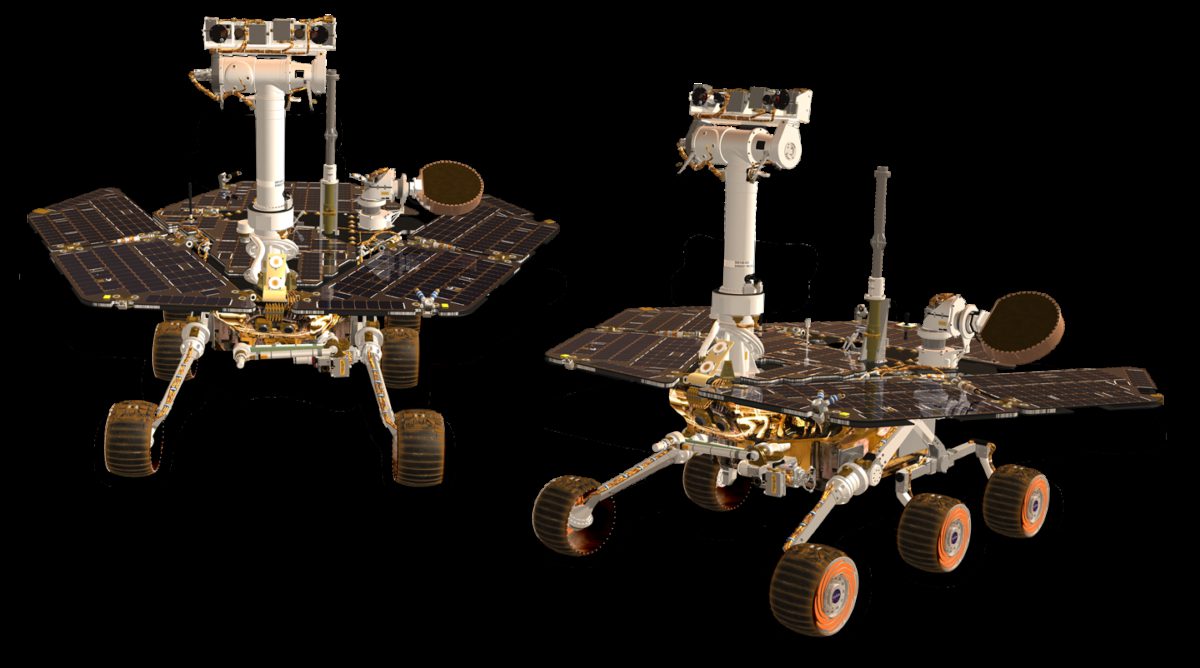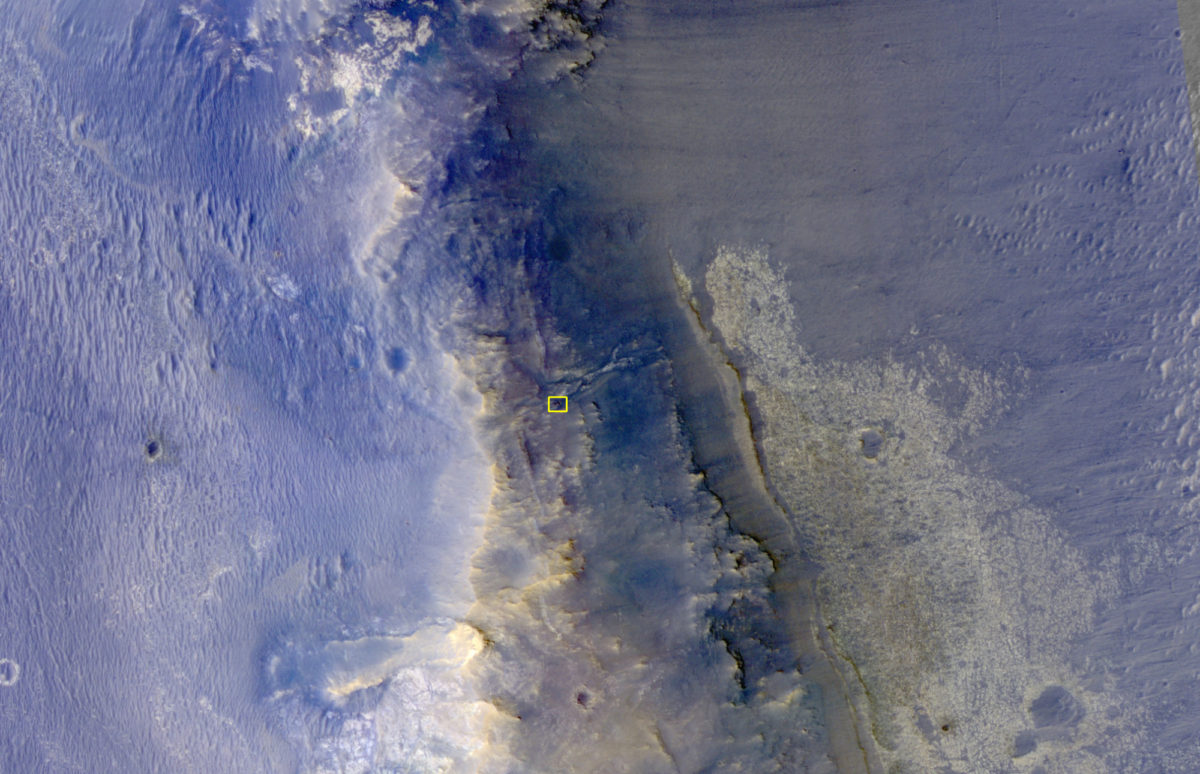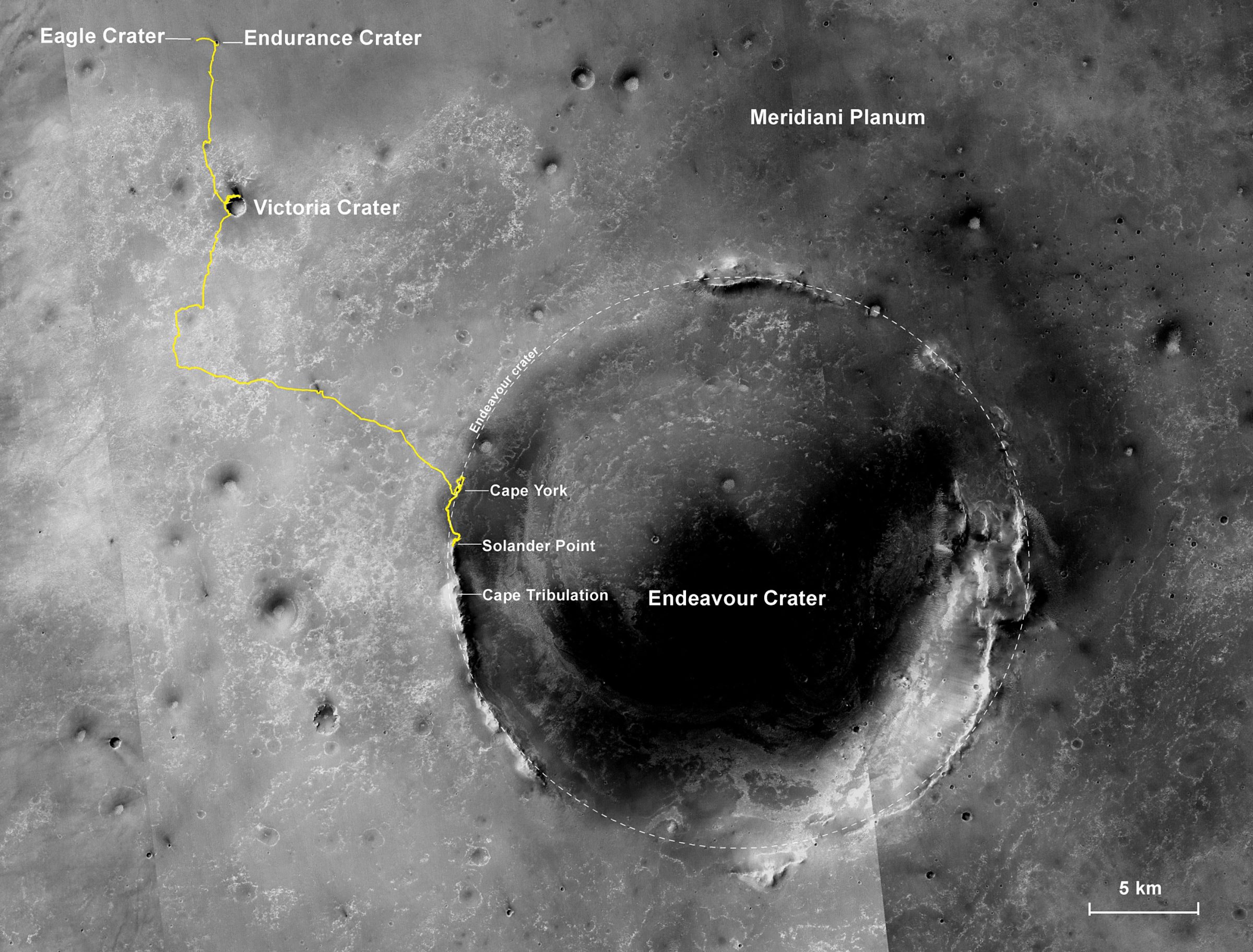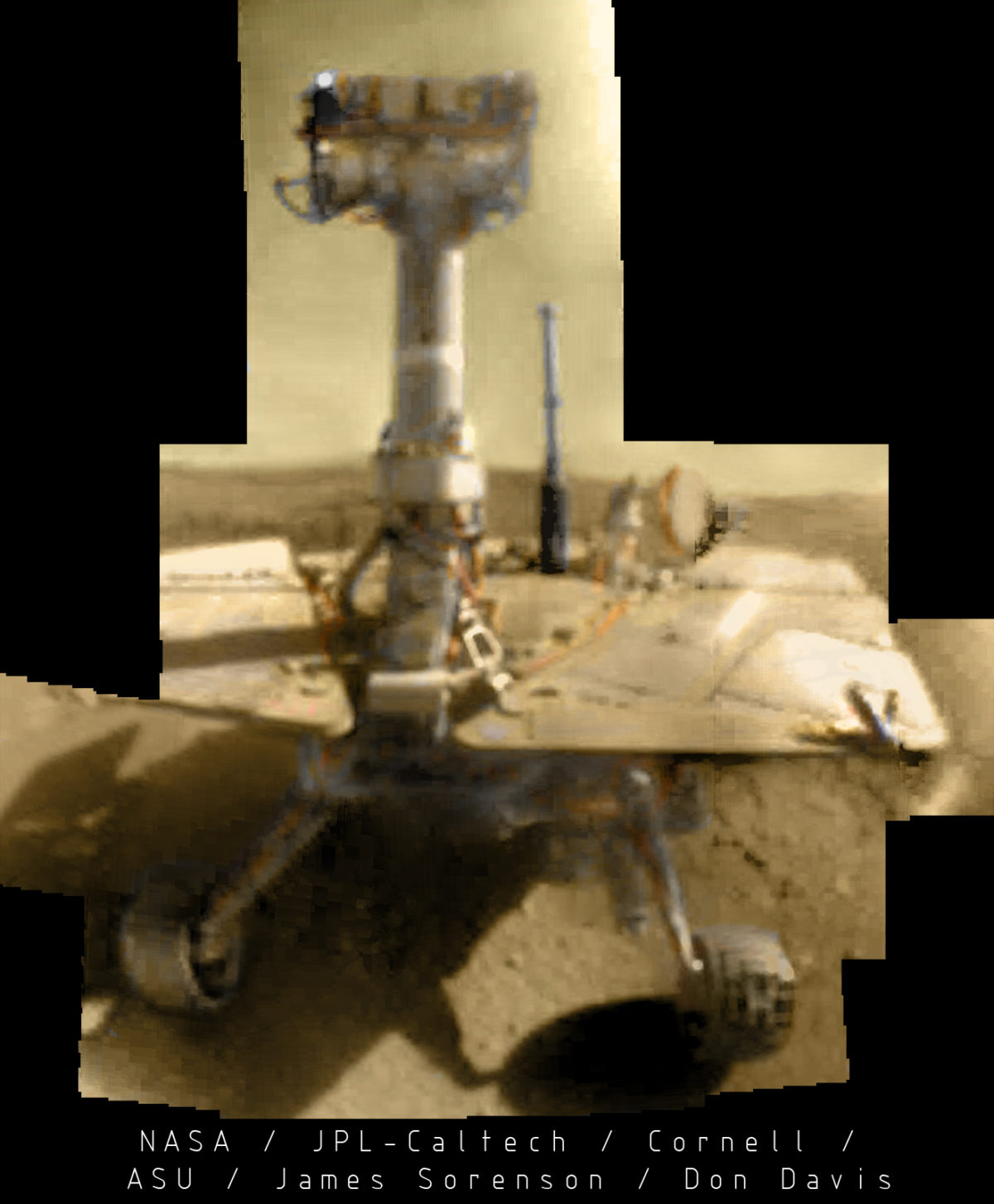A.J.S. Rayl • Feb 14, 2019
The Mars Exploration Rovers Update Special Report: NASA Declares Opportunity and MER Mission 'Complete'
Sols 5342 - 5353
PASADENA, CA, Feb 13 – It happened last night.
At around 8 pm February 12, 2019, Pacific Standard Time (PST), as the strains of Billie Holiday singing “I’ll Be Seeing You” filled the Space Flight Operations Center at the Jet Propulsion Laboratory (JPL), final commands were transmitted to Opportunity.
The Mars Exploration Rover defied all odds – and with the help of her team on Earth – turned a 90-day mission into an overland expedition that inspired generations of young people, produced volumes of data, rewrote textbooks, changed the way humanity saw the Red Planet, created a culture that remarkably blended science and engineering in a way no other NASA mission ever has, and lasted nearly 15 years, had been unresponsive for eight months.

Opportunity downlinked what would turn out to be her final message from Mars on June 10, 2018. The bare bones contents of that missive informed her crew that a monster dust storm was lifting dust all around Endeavour Crater and was turning day into night there. Minutes later, the solar-powered robot field geologist presumably shut down and went into a kind of hibernation mode to wait out the storm.
As Opportunity hunkered down at her post in Perseverance Valley, located inside the big crater’s western rim, the storm pummeled the site and the rover with an unknowable amount of dust. What was known was that the rover was at ground zero of what scientists eventually determined was the worst planet encircling dust event (PEDE) that NASA scientists have ever observed, and likely had suffered a direct hit.
The final ‘Hail Mary’ in a series of last-ditch efforts that began in late January was bolstered by all the hope the MER team could muster. But MER Principal Investigator Steve Squyres, of Cornell University, MER Project Manager John Callas, Michael Staab, the MER Spacecraft Systems Engineer and Flight Director who oversaw development of the ‘Hail Mary’s,’ and others, including NASA and JPL officials also present when the Mission Command and Control Ace, Ashton Vaughs, sent the transmissions, heard only sounds of static silence.
And so, after more than 835 commands sent since last June, the Associate Administrator for the Science Mission Directorate at NASA Headquarters, Thomas Zubuchen, declared the MER mission “complete” at a press conference and celebratory event held Wednesday, February 13, 2019, at JPL, where all NASA’s Mars rovers have been designed, built, and tested.
“It’s heartbreaking, but it had to happen sometime, right?” Squyres told The MER Update. “Everything comes to an end and this is coming to an end. It’s the final act and the biggest thing in my career, and the biggest thing in my life except for my kids, and it feels okay. Can you think of a better way to go out? After fourteen and a half years we get killed off by the worst dust storm observed in 40 years,” he said, pausing. “We should be so proud of what we’ve done, so proud of what we have accomplished – coaxed a solar-powered rover through 14-and-a-half years on Mars when it was designed for three months. It’s astonishing.”
Yet, it marks ‘the end of the world’ as MER team members and followers around the world knew it. “You’ll divide your life into BR and AR, Before Rovers and After Rovers,” said MER Project Manager John Callas. “We’ll think of our lives before the rovers landed, and then our lives after the rovers.”
The reality of that began to hit as the event got underway and emotions were all over the map.

Spirit and Opportunity landed on Mars on January 3, 2004 and January 24, 2004 Pacific Standard Time (PST) respectively, and the whole world was watching. Spirit bounced down in perfect form, and then bounced and bounced and bounced as everyone waited and waited not knowing what was happening. Finally, after sixteen and a half agonizing minutes, the spacecraft stopped and the robot phoned home. The world cheered and news agencies everywhere covered the event, applauding the two little rovers on Mars.
It seemed as if Opportunity’s landing couldn’t get any better, but three weeks later, she upstaged her twin by scoring Earth’s first 300-million-mile, interplanetary hole-in-one, bouncing and then rolling to a stop inside a small crater named Eagle.
The identical twin rovers were originally sent to opposite sides of Mars on three-month exploratory tours to look for signs of past water, and perhaps characterize any places that may have been potential habitats where life could have emerged. A primary engineering objective was for Spirit and Opportunity to drive a total of 600 meters.
The rovers met those science and engineering objectives in their primary missions and then roved on, exceeding expectations and going beyond everyone’s wildest dreams.
“As we went from one place to another, both the rovers and Mars continued to surprise us,” Deputy Principal Investigator Ray Arvidson, of Washington University St. Louis (WUSTL) told The MER Update last week.
Spirit, the alpha twin, had the tougher Martian road to hoe as she navigated her way through the rocky terrain of Gusev Crater to the Columbia Hills, named for the Columbia space shuttle and her crewmembers. From there, this rover hiked up Husband Hill, becoming the first robot to scale a small mountain the height of the Statue of Liberty and make the descent back down. She was also the first to shoot an image of a Martian dust devil as it whirled past.
Though she was something of a drama queen, Spirit was really tough as nails. When her right front steering wheel broke on her way to climb McCool Hill for the coming winter, neither the rover nor her team on Earth gave up. Undaunted, she turned around and drove backwards, dragging her broken wheel to a place where she could tilt her solar arrays to the Sun and survive a second Martian winter.

Spirit’s broken wheel turned out to be a new tool, which churned up the sandy soils of the area around Home Plate. The MER science team eventually concluded the circular formation is an eroded, ancient, extinct fumarole, the opening of a volcano through which hot sulfurous gases spew and that the site may have once featured hot springs, an environment that could have hosted microbial life. By dragging that wheel as she explored Home Plate and the area around it, this rover also uncovered near pure opaline silica, something that never would have been discovered without her broken wheel.
Then in late 2009, as Spirit was driving along just to the west of Home Plate, her left front wheel broke through the thin crusted edge of a shallow crater that is filled with and hidden by sulfate-rich sands. She became embedded. Unable to escape and get properly positioned for the next winter, the rover communicated with the team on March 22, 2010, then settled into a hibernation mode from which she never emerged. NASA-JPL continued to reach out and attempt to re-establish contact with the alpha twin until May 25, 2011. Spirit never responded and NASA announced the end of contact efforts and the completion of the mission that month.
On the other side of Mars, Opportunity explored Eagle Crater and the bedrock that was before her there, and then roved up and out and on to became the first robot to examine her own heat shield, jettisoned on landing. From there, she headed out on a journey across Meridiani Planum, crater hopping as she went. From Endurance Crater, she cruised to Victoria Crater, viewed as the “impossible dream” destination at the beginning of the mission.
Once her work at Victoria was finished, the MER team dispatched her on a three-year traverse to the next “impossible dream” destination. En route, Opportunity ran over a light-toned vein that turned out to be gypsum, a sure-fire sign for the presence of liquid water at some point in the past. As unlikely as it seemed at the start of this cross-country trek, the rover pulled up to Endeavour Crater in 2012, and wound up finding more evidence for a wet ancient environment, a site on Matijevic Hill where more neutral water offered seemingly indisputable evidence that this place may have once provided a habitat favorable for life.
Opportunity – the rover that loves to rover also known as “Little Miss Perfect,” as Jake Matijevic, a member of the original MER development team and then-Chief of MER Engineering called her -- logged no end of achievements and set a host of new records along the way.
Beyond becoming the first rover to drive into a crater on Mars, Opportunity became the first rover in the solar system to complete a marathon in 2015, setting a new record for extraterrestrial travel, and establishing the drive record to beat for Curiosity and future rovers on Mars.
In addition to the MERs’ mettle and resilience, the infamous Mars winds turned out to be as much friend as foe, kicking up winds in the spring and summer seasons that would regularly, almost reliably clear significant amounts of accumulated dust on the rover’s solar arrays.

With their uncanny, individual personalities and quirks, Spirit and Opportunity helped produce the most experienced Mars rover experts on Earth, and the MER team was as honored and celebrated as the two robot field geologists at the press event Wednesday for the legacies they leave behind.
The MER legacy continues not just in the Curiosity rover, said JPL Director Michael Watkins, but also in the new 2020 rover, now under construction at JPL. “But it turned out the team did something more than that,” he said.
“They energized the public about the spirit of robotic Mars exploration and they brought that to light, these two little intrepid rovers and an incredibly energetic and dedicated ground team,” Watkins continued. “The infectious energy and electricity that this mission created was obvious to the public. That legacy turned out not only a generation of engineers and scientists, of which I am one, but also a generation of students. Many students who were inspired to go into STEM career and a few of them actually came here to work on Opportunity.”
When all good things that must end finally come to that end however, there is no denying the feelings that accompany such finalities. The MER team members, both present and past who were at the event, each of whom bonded with Spirit and Opportunity to one degree or another, in one way or another, wrestled with their emotions, and their good-byes.
“It’s hard at this point,” said Rover Planner Ashley Stroupe, who earned the distinction at JPL as the first woman driver on Mars. “It’s very fresh and I don’t know that I’ll ever have an experience that matches it. What I am feeling is that it’s just been such a privilege to go on this journey with these people and these rovers.”
Gratitude is something that has been present among the members of the MER team since the very beginning, and without doubt, that is one major reason that this mission has been so successful, something written about in the pages of The MER Update on numerous occasions. Squyres even capsulized it in a kind of team mantra or motto: Every day on Mars is a gift. And the team took it seriously, very seriously.
“It’s so hard to know what to say. I feel so emotionally exhausted,” said MER Power team lead Jennifer Herman. “Part of me feels terribly broken-hearted, like there’s been a death in the family. Opportunity was so present in my life. I checked on her every day. I scheduled lunches and meetings and doctor appointments around her downlink schedule. I scheduled vacations and even the birth of my child around the Martian seasons so I could be available when she needed me the most. I have felt an emptiness in the Oppy part of my life for the last eight months and now I know today that it will never go away,” she said.
“But on the other side, I feel so proud and grateful for having had the privilege of being on the MER project for the last 14 years,” Herman continued. “I am proud because we didn’t lose Opportunity because of a broken part or a sequencing error. We lost her because Mars is a harsh, harsh environment. Oppy held out more than 50 times longer than her life expectancy. I am so grateful because I was able to be a part of one of the most amazing collaborations of scientists and engineers that I could ever imagine. We engineers had such profound respect and admiration for our science team and we knew that they respected us engineers too. It has been an honor to work with them all. These have been the most cherished years of my career.”

The hope that always sprung eternal among this team, and that helped fuel the mission since the beginning may have faded to history now as Opportunity is decommissioned, but the gratitude seems only to have grown, if that’s possible, beyond the ‘gift’ to encompass each other.
“This project has been unique and holds a special place in my heart, because of how the team has operated,” said JPL’s MER Chief of Engineering Bill Nelson. “We are surprisingly collegial. The team has worked very well together and we have managed to keep two rovers rolling and to achieve a lot of very good science for many years. Even after the loss of Spirit, we have achieved quite a bit more with just Opportunity, so if it’s not the highlight, it’s certainly one of the highlights of my life to have been involved in this project, working on this team, and who wouldn’t be grateful for that?”
The collegial relationship between scientists and engineers established a “culture,” as Squyres defined it. That culture “blended engineering and science” to the point where a hypothetical visitor to the MER meetings “probably wouldn’t be able to tell which of the team members were scientists and which were engineers,” he said.
Given that engineers and scientists are generally two distinctively different, disparate types of people with different approaches to their work, and blending them is, well – quite an achievement.
This blended culture is, by any thoughtful reckoning, a new model for all NASA missions, since the space agency is and has always been about the scientists who want to go places and the engineers who get them there. Clearly, it impacted virtually every MER team member in every good way and each seems to feel they are leaving this mission so much the better for it.
“Working with Steve Squyres, Ray Arvidson, Rob Sullivan, Jake Matijevic and many others opened my mind and made me understand how interdisciplinary studies are vital to human endeavors,” said Paolo Bellutta, the robotics expert who worked with the MER scientists and other rover planners to chart Opportunity’s routes into Victoria, across Meridiani Planum and through the western rim of Endeavour.
“In my many years working in robotics, I always tried to keep in focus the big picture, but working with them on MER was at a much, much higher level,” Bellutta said. “I'm thankful to all the scientists who spent many hours explaining to me the details behind all the issues we had during the rover voyage.”
Even for Arvidson, who has more Martian dust on his khakis than any other planetary scientist – having participated in all of the U.S.-led Mars landed missions except for Pathfinder – MER represents a “highlight” in a distinguished career that includes field work on current and past environmental processes and conditions on Earth, in the Eastern and Western Deserts of Egypt, Western Greenland, the Mojave Desert, the Big Island of Hawaii, and the Missouri River and floodplain.

“Continuing field work with Spirit and Opportunity has been a privilege and challenge, and has led to many exciting discoveries about current and past ways water has interacted with the Martian surface and subsurface,” said Arvidson.
Now overseeing the archiving of all the digital data products that the MER mission returned during the last decade and a half for the Planetary Data System (PDS), which stores all data returned from NASA's planetary missions, Arvidson added: “As the MER mission winds down, we leave an historical and lasting legacy of discoveries, as well as the knowledge and experience of how to implement a mission that has lived long after the expected lifetimes of our two robotic companions.”
As the press event and team celebration was coming to a close, Squyres offered his final thoughts on the end of the mission. “For me, it’s bittersweet. But what makes me feel so good right now is my family – here in this room,” he said in an emotional moment. “And I will always be grateful for this."
“It is sad, and it’s going to be hard to top this mission,” concluded Callas. “But at the same time, saying ‘Good-bye’ to something allows you to say ‘Hello’ to something else. Space exploration will forever continue, and now it’s time for the next mission.”
For many though, the final song played during the final transmission to Opportunity, will likely resonate, if somewhat differently, for many on the team for along time to come.
We’ll be seeing you Oppy / In all the familiar places / that these hearts of ours embrace.
And when the night is new / we’ll be looking at Mars / and we’ll be seeing you [1]
The Mars Exploration Rovers Update will present a more in-depth mission wrap-up in coming weeks.
[1] Adapted from “I’ll Be Seeing You,” music by Sammy Fain, lyrics by Irving Kahal
WE LET YOU GOSo unjust, so unfair that in the end it was the dust that killed you,
Not the natural wear and tear or honourable rust of old age.
Everyone who loved you knew the Sol would come
When Mars finally murdered you; we expected
Howls of rage as an axle broke
Or your computer had a stroke,
But not… this.Around the world, laboratories and living rooms alike
Were filled with helpless sighs as that dust storm
Covered Endeavour’s Big Country sky, swirling ochre clouds
Of fines blotting out your Sun and settling on your back,
Blinding you, smothering you, choking you…Today, as they declare your mission has ended
And the Deep Space Network’s great concave ears
Turn away from you with a grinding and groaning of gears
I can’t help wondering if you’re still alive.
Does your electronic pilot light still flicker inside you?
Does your brave digital heart still beat in your deep, deep sleep?
Have we abandoned you too soon?
Are Barsoom’s twin moons shining down on you
As you cling stubbornly to life, needing just one more
Whisper of code to prise open your dust-caked eyes?We’ll never know.
There’ll be no more calling out your name from Earth’s front porch;
We’ve gone inside and closed the door behind us
Because there’s nothing left to try.
Every die has been thrown a dozen times;
Every desperate plea shouted at the sky has gone unanswered.
No-one can do any more,
So it’s time to say goodbye.Perhaps, on one far future day, a weary Martian,
Standing on Cape Tribulation’s sunlit peak
Will sweep their gaze up and down the meandering
Curves of Perseverance Valley and see you standing there -
A statue, thick with dust, your shadow stretching down to
And out across Endeavour’s floor – and bound down to you,
Sweeping your back clean with their gloved hands
And understand the treasure they’ve found…But our time with you is over.
And so, Opportunity, our brave, bold girl,
We let you go.
© Stuart Atkinson 2019
Support our core enterprises
Your support powers our mission to explore worlds, find life, and defend Earth. You make all the difference when you make a gift. Give today!
Donate

 Explore Worlds
Explore Worlds Find Life
Find Life Defend Earth
Defend Earth

